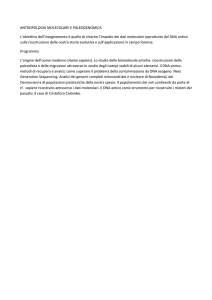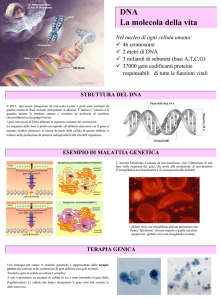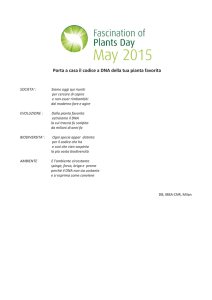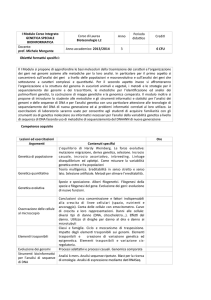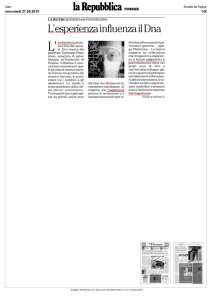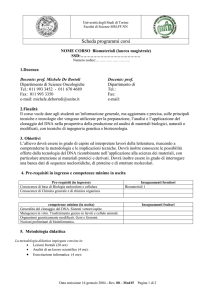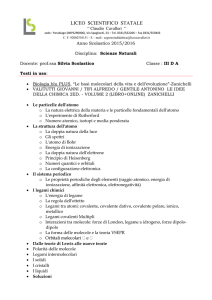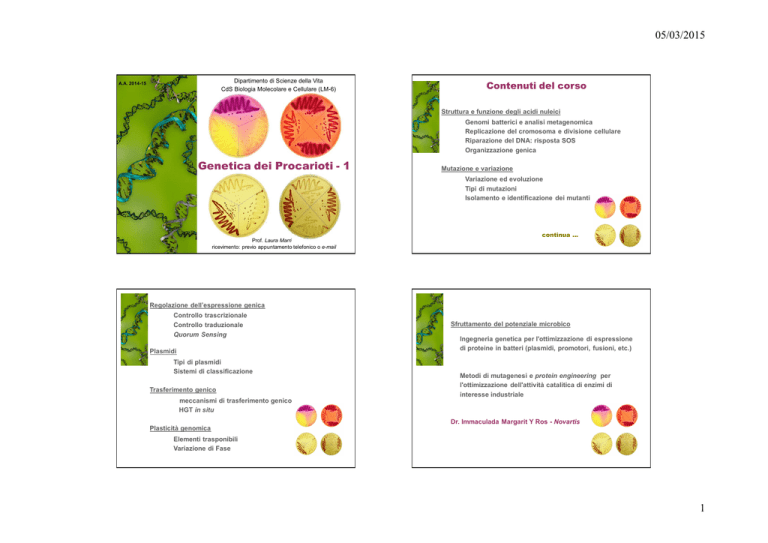
05/03/2015
Dipartimento di Scienze della Vita
CdS Biologia Molecolare e Cellulare (LM-6)
A.A. 2014-15
Contenuti del corso
Struttura e funzione degli acidi nuleici
Genomi batterici e analisi metagenomica
Replicazione del cromosoma e divisione cellulare
Riparazione del DNA: risposta SOS
Organizzazione genica
Genetica dei Procarioti - 1
Mutazione e variazione
Variazione ed evoluzione
Tipi di mutazioni
Isolamento e identificazione dei mutanti
continua …
Prof. Laura Marri
ricevimento: previo appuntamento telefonico o e-mail
Regolazione dell’espressione genica
Controllo trascrizionale
Controllo traduzionale
Quorum Sensing
Plasmidi
Tipi di plasmidi
Sistemi di classificazione
Trasferimento genico
Sfruttamento del potenziale microbico
Ingegneria genetica per l'ottimizzazione di espressione
di proteine in batteri (plasmidi, promotori, fusioni, etc.)
Metodi di mutagenesi e protein engineering per
l'ottimizzazione dell'attività catalitica di enzimi di
interesse industriale
meccanismi di trasferimento genico
HGT in situ
Dr. Immaculada Margarit Y Ros - Novartis
Plasticità genomica
Elementi trasponibili
Variazione di Fase
1
05/03/2015
Testi consigliati per la consultazione
J.W. Dale & S.F. Park
MOLECULAR GENETICS
OF BACTERIA
5th Ed. Wiley, 2010
Madigan, Martinko, Parker
BROCK, BIOLOGIA DEI
MICRORGANISMI voll.1, 2, 3
Pearson Italia Milano-Torino, 2012
Testi consigliati per la consultazione
N. Trun & J. Trempy
Fundamental
BACTERIAL GENETICS
Wiley-Blackwell, 2003
http://www.blackwellpublishing.com/trun/default.htm
G. Dehò & e. Galli
BIOLOGIA DEI MICRORGANISMI
2a Ed. CEA, 2014
Articoli
scientifici
Modalità di esame
scritto, domande a risposta breve.
Appelli 2015
9 giugno
21 luglio
8 settembre
10 ottobre
N.B.: Le date riportate sono suscettibili di modifiche
2
05/03/2015
1866
Mendel scopre I geni
1943
il DNA è IL materiale genetico
1951
prima sequenza di una proteina (insulina)
1953
struttura del DNA
1959
struttura della mioglobina
1960s
delucidazione del codice genetico
1977
sequenziamento del DNA
1975-79
primi clonaggi di geni umani
1986
sviluppo di un sistema di seq. aut. del DNA
1995
primo genoma completo (Haemophilus influenzae)
1997
Genoma di Escherichia coli
1999
primo cromosoma umano (Chr #22)
2000
Drosophila / Arabidopsis genomi
2001
genomi dell’uomo e di topo
S-Type Carbohydrates S-Type
Destroyed
Lipids
Destroyed
S-Type
Proteins
Destroyed
S-Type RNA S-Type DNA
Destroyed
Destroyed
Conclusion:
DNA was the transforming
factor!
Griffith’s Experiments, 1929
R
R
Mice injected with
live cells of harmless
strain R do not die.
Live R cells in their
blood.
S
Mice injected with live
cells of killer strain S
die. Live S cells in their
blood.
Mice injected with heatkilled S cells do not die.
No live S cells in their
blood.
Mice injected with
live R cells plus
heat-killed S cells
die. Live S cells in
their blood.
Hershey and Chase’s Experiments, 1952
35S
remains
outside cells
Virus particle
coat proteins
labeled with 35S
DNA being
injected into
bacterium
Virus DNA
labeled with 32P
32P
remains
inside cells
Labeled DNA
being injected
into bacterium
3
05/03/2015
Genoma
INFORMAZIONE GENETICA NEI PROCARIOTI.
L’informazione genetica della cellula procariotica è
costituita dal DNA cromosomale (uno o più
cromosomi) e dal DNA extracromosomale (plasmidi).
Cromosomi e plasmidi possono essere sotto forma di
molecole sia circolari sia lineari.
insieme delle informazioni genetiche che
sono costituite dai geni, dalle loro
sequenze regolative e dalle sequenze di
13
DNA non codificanti
I due tipi di DNA possono essere portatori di diverse
classi di elementi genetici (genomi virali, plasmidi e
trasposoni).
La lisi della cellula batterica,
con trattamenti delicati,
libera il cromosoma sotto
forma di molecola continua
di DNA di dimensioni molto
superiori alla lunghezza del
batterio.
4
05/03/2015
Prokaryotic Chromosomes
How many base pairs are there in the E. coli chromosome?
kb (= kbp) = kilo base pairs = 1,000 bp
Mb = mega base pairs = 1,000,000 bp
Eukaryotic Chromosomes
Many prokaryotes contain a single
circular chromosome
Eukaryotes contain multiple linear
chromosomes
P. chromosomes are condensed in the
nucleoid via DNA supercoiling and the
binding of various architectural proteins
E. chromosomes are condensed in a
membrane-bound nucleus via histones
Transcription and translation occur
simultaneously
Transcription occurs in the nucleus, and
translation occurs in the cytoplasm
Most prokaryotes contain only one copy
of each gene (i.e., they are haploid).
Most eukaryotes contain two copies of
each gene (i.e., they are diploid).
Nonessential prokaryotic genes are
commonly encoded on
extrachromosomal plasmids
Extrachromosomal plasmids are not
commonly present in eukaryotes.
P. genomes are efficient and compact,
containing little repetitive DNA.
E. contain large amounts of noncoding
and repetitive DNA.
LE PRINCIPALI PROTEINE ASSOCIATE AL NUCLEOIDE.
La figura illustra in modo
approssimativo le
dimensioni del DNA non
compattato rispetto alle
dimensioni della cellula.
5
05/03/2015
Bacterial chromosomes ranges from 0.6 Mbp to over 10 Mbp
Archael chromosomes range from 0.5 Mbp to 5.8 Mbp
Science, 1995, Vol 269:496-512
1.83 Mbp
Mar. 2014: 3654 citazioni
Mar. 2015: 3769 citazioni
project
E. coli K-12
disease
nonpathogen;
reference
strain
strain
MG1655
genome plasmid(s)*
size
4.6 Mb
5.4 Mb
uropathogenic cystitis,
CFT073
E. coli
pylonephritis
(UPEC)
5.2 Mb
E. coli K1
(NMEC)
5.2 Mb
Brook, Biologia dei
microrganismi – 1
Microbiologia generale
(none) published (1997)
updated
June 10, 2004
I genomi procarioti sequenziati hanno dimensioni che vanno da
0,16 Mbp a 13 Mbp, e sono noti genomi anche di dimensioni
maggiori.
Il più piccolo genoma procariote ha dimensioni minori di quelle del
genoma virale più grande.
E. coli O157:H7 haemorrhagic EDL933
(EHEC)
colitis,
haemolytic
uremic
syndrome
septicemia,
neonatal
meningitis
status
RS218
2 published (2001)
Feb 13, 2001
I genomi procarioti più grandi hanno più geni di alcuni genomi
eucarioti.
(none) published (2002)
1 finishing (assembly in 3
contigs)
Dec 5, 2002
Il contenuto genico nei procarioti è caratteristicamente
proporzionale alle dimensioni del genoma.
May 17, 2006
Molti geni possono essere identificati attraverso la loro similitudine
di sequenza con i geni che si trovano in altri organismi.
Una significativa percentuale di geni sequenziati, però, è ancora a
funzione sconosciuta.
23
6
05/03/2015
N. of genes (ORFs) plotted against genome size for 44 fully sequenced
Genome sequencing is just the beginning to appreciate biocomplexity
Genes with known
function: ~ 40%
genomes, including ten Archaea (squares) and 34 Bacteria.
Mesorhizobium
loti
Genes with unknown
function: ~60%
In ogni genoma esaminato circa
¼
“ipotetico”
mollicutes
Escherichia coli: 1000 geni /4300 totali
Summary of the shifts in gene content with genome size in prokaryotic genomes.
Konstantinidis K T , and Tiedje J M PNAS 2004;101:31603165
Brook, Biologia dei
microrganismi – 1
Microbiologia generale
28
7
05/03/2015
R.F. DOOLITTLE Nature 416, 697 - 700 (2002)
Pelagibacter ubique
Stages of genome reduction in host-restricted bacteria for which small
population sizes and an asexual life cycle result in mutation fixation.
Note that some symbionts and pathogens (such as Rhizobium spp. and Vibrio fischeri) that can persist
in the outside environment and that re-infect hosts frequently do not undergo these genomic changes
1,308,759 bp, 30% of the cell volume
8
05/03/2015
Genes involved in informational processing are in blue, those involved in vitamin
or amino acid biosynthesis are in maroon, ribosomal RNA genes are in green,
other genes are light grey and breaks are non-coding regions.
The total number of prokaryotic cells on earth has been estimated
to be approximately 4-6 × 1030
Minimal genome is defined as
the gene set that is sufficient for life under
lenient (nutrient-rich and stress-free) conditions
Il concetto si è sviluppato dalla metà degli anni ‘90
How Simple Can Life Get? . . . It’s complicated
In a particular environment, the sum of all microbial genes
corresponds to the METAGENOME.
9
05/03/2015
Metagenomica
Metagenomica (detta anche genomica ambientale) è lo
studio dei genomi recuperati da ambienti piuttosto che da
singoli organismi
Comunità intestinali, comunità marine (es. i batteri del mar
dei Sargassi), biofilm …..
10
05/03/2015
"whole-genome
shotgun sequencing"
Sargasso Sea,
Bermuda
11
05/03/2015
Fig. 1. MODIS-Aqua satellite image of ocean chlorophyll in the Sargasso Sea grid about the BATS site
from 22 February 2003
"whole-genome shotgun sequencing"
Sargasso Sea, Bermuda
1700 litri
filtri:0.1-3.0 micron
1.045 miliardi bp di sequenze non ridondanti analizzate
1800 specie, di cui 148 sconosciute
1.2 milioni di geni
J. C. Venter et al., Science 304, 66 -74 (2004)
L’analisi metagenomica del terzo
segmento dell’intestino posteriore delle
termiti ha rivelato la presenza di 12
Phyla e 216 filotipi (nessuno collocabile
nel dominio Archaea)
12
05/03/2015
Complete Genome Projects
Metagenomi: 547
Of the 395 bacterial phylotypes, 244 (62%) were novel and 80%
represented sequences from species that have not been cultivated
MetaHIT (Metagenomics of the Human Intestinal Tract)
January 1, 2008 - June 30, 2012
project financed by the European
Commission under the 7th FP program. The
consortium gathers 13 partners from
academia and industry, a total of 8 countries.
Its total cost has been evaluated at more than
21,2 million €
March 4 2010
13
05/03/2015
Why bacteria matter in animal development and evolution
BioEssays
Volume 32, Issue 7, pages 571-580, 11 JUN 2010 DOI: 10.1002/bies.200900192
http://onlinelibrary.wiley.com/doi/10.1002/bies.200900192/full#fig2
Why bacteria matter in animal development and evolution
BioEssays
Volume 32, Issue 7, pages 571-580, 11 JUN 2010 DOI: 10.1002/bies.200900192
http://onlinelibrary.wiley.com/doi/10.1002/bies.200900192/full#fig6
14
05/03/2015
Trends in Biotechnology
Volume 28, Issue 12, December 2010, Pages 611-618
Number of publicly available genome sequences for selected bacterial pathogens
Yersinia pseudotuberculosis (batterio del suolo)
Species
N. of draft (or “in
progress”) genomes
N. of finished
genomes
Bacillus anthracis
20
6
Bacillus cereus
43
9
Borrelia burgdorferi
12
5
Chlamidia trachomatis
23
20
Clostridium botulinum
8
11
Escherichia coli
270
38
Haemophilus influenzae
25
4
Listeria monocytogenes
24
6
Mycobacterium tuberculosis
71
5
Yersinia pestis è considerato un clone diY. pseudotuberculosis comparso
Salmonella enterica
62
18
negli ultimi 1.500 – 20.000 anni in seguito all’acquisizione dei plasmidi
Staphylococcus aureus
69
21
pMT1
Streptococcus pneumoniae
186
12
Yersinia pestis
& pPCP1
3 PANDEMIE
~ 200
milioni
di morti
6th sec., Africa/Asia
14th sec., Europa (1/3 popolazione europea)
19th/20th sec., Asia
Negli ultimi 20 anni ci sono stati da 1000 a 5000 casi di peste e da
100 a 200 decessi all’anno (WHO)
(A) Map showing countries with known presence of plague in wild reservoir species
(B) Annual number of human plague cases over different continents, reported to WHO
1954–2005.
(C) Cumulative number of countries that reported plague to WHO since 1954.
15
05/03/2015
East Smithfield
(fossa comune scavata tra il 1348 e il 1349 per seppellire le vittime della pandemia)
“genomics era”
‘population genomics era’
The ancient sequence is surprisingly similar to modern Y. pestis strains.
It differed from modern strains at only 97 positions all of which matched
the ancestral genes from Yersinia psuedotuberculosis.
collection of multiple genomes of a
bacterial species
tight genetic conservation in this organism over the last 660 years
The genes of the Black Death clones do not have significant
genetic differences that would make the ancient clone(s) more
(or another discrete taxonomic unit)
PAN-GENOME
virulent than modern strains.
A pan-genome is the sum of all genomes of similar strains; each having
similar (core genome) or distinct (cenomes) sets of nonpersistent genes.
∼500 persistent genes form the paleome.
16
05/03/2015
Pan-genome of 5 members of Thermotogales.
Zhaxybayeva O et al. PNAS 2009;106:5865-5870
©2009 by National Academy of Sciences
For the time being, the pan-genome of E. coli is composed of roughly 20000 genes,
the majority of which (80%) is often colocalized on genomic islands.
For a particular E. coli strain with a genome of 4500 genes the cenome alone would
be about 4000 genes
1 MEGABASE PROKARYOTIC
DNA = 1000 ORFs
17
05/03/2015
Phenotype
Ensable of observable characteristics of an organism
Genotype
Organism’s genetic material
Gene
discret unit of genetic information
Mutation
process by which genes undergo a structural change
OPERONE
OPERONE
unità che coordina e regola la trascrizione nei batteri
Un operone comprende:
un set di geni strettamente correlati che sono regolati da un
singolo operatore e trascritti insieme
18
05/03/2015
OPERONE
REGULONS
Regulons, as groups of transcriptionally co-regulated operons, are
the basic units of cellular response systems in bacterial
P
O
Gene A
Gene B
Gene C
T
A bacterial regulon is a group of operons that are transcriptionally co-
mRNA 5‘
3‘
regulated by the same regulatory machinery, consisting of trans
regulators (transcription factors or simply TFs) and cis regulatory
binding elements in the promoters of the operons they regulate.
proteine
A
B
C
“activator binding site”
Regolatore: codifica per una proteina regolatrice
Operatore: regione dove si lega la proteina regolatrice
Promotore: sequenza riconosciuta dalla RNA pol. DNA dip.
Geni strutturali: uno o più geni codificanti attività correlate
gene
regolatore
P
gene1
gene2
gene3
TF
REGULONS
Operationally, a regulon contains operons regulated by one
same transcription factor.
attivatore
19
05/03/2015
REGULONS
REGULATED GENES AND CO-REGULATORS OF CRP
CRP: cAMP receptor protein
o CAP: catabolite gene activator protein
Since the term regulon was first proposed in 1964, 173
regulons have been fully or partially identified in E. coli K12
and numerous more in other bacteria e.g. B. subtilis.
Regulons can be categorized into two classes:
LOCAL: consisting of only a few component operons
GLOBAL: having a relatively large number of operons
The intersection contains those TFs that are directly regulated by CRP
and which work as co-regulators with CRP.
20

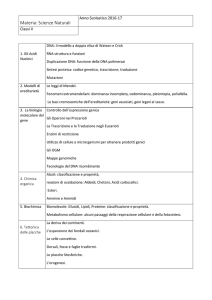
![mutazioni genetiche [al DNA] effetti evolutivi [fetali] effetti tardivi](http://s1.studylibit.com/store/data/004205334_1-d8ada56ee9f5184276979f04a9a248a9-300x300.png)


